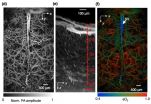(Press-News.org) Washington, D.C.-- The 2000-2003 drought in the American southwest triggered a widespread die-off of forests around the region. A Carnegie-led team of scientists developed a new modeling tool to explain how and where trembling aspen forests died as a result of this drought. It is based on damage to the individual trees' ability to transport water under water-stressed conditions.
If the same processes and threshold govern the future, their results suggest that more widespread die-offs of aspen forests triggered by climate change are likely by the 2050s. Tree mortality can radically transform ecosystems, affect biodiversity, harm local economies, and pose fire risks, as well as further increase global warming.
Their work aimed to address a longstanding disagreement over how climate change caused by the emission of greenhouse gasses will affect forest ecosystems. On one hand, rising concentrations of carbon dioxide can benefit trees and help them use water more efficiently. On the other hand, rising temperatures and resulting droughts from climate change can cause many forest trees to die off. Most current models of forests under climate change cannot predict when or where forests might die from temperature and drought stress. The model created by the team including Carnegie's William Anderegg (now at Princeton University), Joseph Berry, and Christopher Field fills this gap by accurately simulating the widespread aspen mortality caused by the 2000-2003 drought. Their findings are published by Nature Geoscience.
Forests are central to many of the planet's chemistry and energy cycles. They also play an important role in human life on the planet both aesthetically and by providing lumber, as well as fruits and nuts for food.
"A forest die-off over a large area like the Amazon Basin, could have a major impact on Earth's system as a whole," said Berry.
The drought-triggered aspen die-off has affected about 17 percent of aspen forests in Colorado, as well as parts of the western United States and Canada. In order to make an accurate model, the team focused on the physiology of how drought kills trees, a subject they have studied extensively in recent years.
They found that drought causes damage to the vascular system that transports water throughout the tree. The threshold for a lethal amount of vascular damage was not previously known in any tree species. But using data from forests in southwest Colorado, they were able to identify a threshold over which drought conditions start to degrade an aspen's water-transporting vascular system. They incorporated this information into a model designed to predict drought-induced forest mortality. They tested the model against regional forest mortality observations from scientific forest plots, aerial surveys done by the U.S. Forest Service, and satellite measurements.
When this model was then applied to the future, they found that in a world of continuing high greenhouse gas emissions, the threshold for widespread drought-induced vascular damage would be crossed and initiate widespread tree deaths on average across climate model projections in the 2050s. Crucially, lower greenhouse gas emissions scenarios did not always lead to widespread tree mortality.
The team also included Alan Flint and Lorraine Flint of the United States Geological Survey, Cho-ying Huang of National Taiwan University, Frank Davis of the University of California Santa Barbara, and John Sperry of University of Utah.
"Finding the thresholds in plant physiology after which climate stress causes tree mortality will allow us to resolve uncertainty over the fate of forest ecosystems in a changing climate," said lead author Anderegg. "But most importantly, a lot rides on human decisions to slow climate change. The clock is ticking on the future of these forests."
INFORMATION:
This work was funded by an NSF DDIG grant, the NOAA Climate and Global Change Postdoctoral Fellowship program, the Department of Energy Office of Science Graduate Fellowship Program, the Ministry of Science and Technology of Taiwan, National Taiwan University, the National Science Foundation Macrosystems Biology Program, and the Carnegie Institution for Science.
The Carnegie Institution for Science (carnegiescience.edu) is a private, nonprofit organization headquartered in Washington, D.C., with six research departments throughout the U.S. Since its founding in 1902, the Carnegie Institution has been a pioneering force in basic scientific research. Carnegie scientists are leaders in plant biology, developmental biology, astronomy, materials science, global ecology, and Earth and planetary science.
Researchers studying cancer and other invasive diseases rely on high-resolution imaging to see tumors and other activity deep within the body's tissues. Using a new high-speed, high-resolution imaging method, Lihong Wang, PhD, and his team at Washington University in St. Louis were able to see blood flow, blood oxygenation, oxygen metabolism and other functions inside a living mouse brain at faster rates than ever before.
Using photoacoustic microscopy (PAM), a single-wavelength, pulse-width-based technique developed in his lab, Wang, the Gene K. Beare Professor of Biomedical ...
DENVER - Low pre-surgery uptake of a labeled glucose analogue, a marker of metabolic activity, in the primary tumor of patients with stage I non-small cell lung cancer (NSCLC) is associated with increased overall survival and a longer time before tumor recurrence. Patients with high labeled glucose uptake may benefit from additional therapy following surgery.
Surgery is the standard of care for patients with stage I NSCLC but not all patients are cured, as demonstrated by a 5-year survival rate of less than 60% in these patients. There is a clear need for a diagnostic ...
DETROIT - A "perverse disincentive" for hospitals that have invested in expensive technology for robotic surgery may be jeopardizing prostate cancer patients who seek out the procedure, concluded a new study led by Henry Ford Hospital researchers.
The study, which compared complication rates in hospitals with low volumes of robot-assisted radical prostatectomies (RARPs) to institutions with high volumes of the procedure, suggested that current pay-for-performance healthcare models are to blame.
The new study was published online this month by BJU International.
"Patients ...
March 30, 2015 - In women undergoing breast augmentation, a technique using transplantation of a small amount of the patient's own fat cells can produce better cosmetic outcomes, reports a study in the April issue of Plastic and Reconstructive Surgery®, the official medical journal of the American Society of Plastic Surgeons (ASPS).
In particular, the fat grafting technique can achieve a more natural-appearing cleavage--avoiding the "separated breasts" appearance that can occur after breast augmentation, according to the report by Dr. Francisco G. Bravo of Clinica ...
Researchers have shown that a known antibiotic and antifungal compound produced by a soil microbe can inhibit another species of microbe from forming biofilms--microbial mats that frequently are medically harmful--without killing that microbe. The findings may apply to other microbial species, and can herald a plethora of scientific and societal benefits. The research is published online ahead of print on March 30, 2015, in the Journal of Bacteriology, a publication of the American Society for Microbiology. The study will be printed in a special section of the journal ...
From smartphones and tablets to computer monitors and interactive TV screens, electronic displays are everywhere. As the demand for instant, constant communication grows, so too does the urgency for more convenient portable devices -- especially devices, like computer displays, that can be easily rolled up and put away, rather than requiring a flat surface for storage and transportation.
A new Tel Aviv University study, published recently in Nature Nanotechnology, suggests that a novel DNA-peptide structure can be used to produce thin, transparent, and flexible screens. ...
(TORONTO, Canada - March 30, 2015) - Biomedical researchers led by Dr. Gang Zheng at Princess Margaret Cancer Centre have successfully converted microbubble technology already used in diagnostic imaging into nanoparticles that stay trapped in tumours to potentially deliver targeted, therapeutic payloads.
The discovery, published online today in Nature Nanotechnology, details how Dr. Zheng and his research team created a new type of microbubble using a compound called porphyrin - a naturally occurring pigment in nature that harvests light.
In the lab in pre-clinical ...
Maternal diet during pregnancy and lactation may prime offspring for weight gain and obesity later in life, according to Penn State College of Medicine researchers, who looked at rats whose mothers consumed a high-fat diet and found that the offsprings' feeding controls and feelings of fullness did not function normally.
Previous research shows that obesity compromises the neurocircuits that control how the stomach and intestine work to regulate how much we eat, and that the time around pregnancy and lactation is important in the development of these circuits. In both ...
A new study shows that workplace wellness programs can be effective in helping people lose weight by providing healthier food choices and increasing opportunities for physical activity, particularly if these efforts are designed with the input and active participation of employees. The two-year project - the results of which appear in the American Journal of Public Health - successfully reduced the number or people considered overweight or obese by almost 9 percent.
"Worksites are self-contained environments with established communication systems where interventions ...
In computer-science classes, homework assignments consist of writing programs. It's easy to create automated tests that determine whether a given program yields the right outputs to a series of inputs. But those tests say nothing about whether the program code is clear or confusing, whether it includes unnecessary computation, and whether it meets the terms of the assignment.
Professors and teaching assistants review students' code to try to flag obvious mistakes, but even in undergraduate lecture courses, they usually don't have time for exhaustive analysis. And that ...

